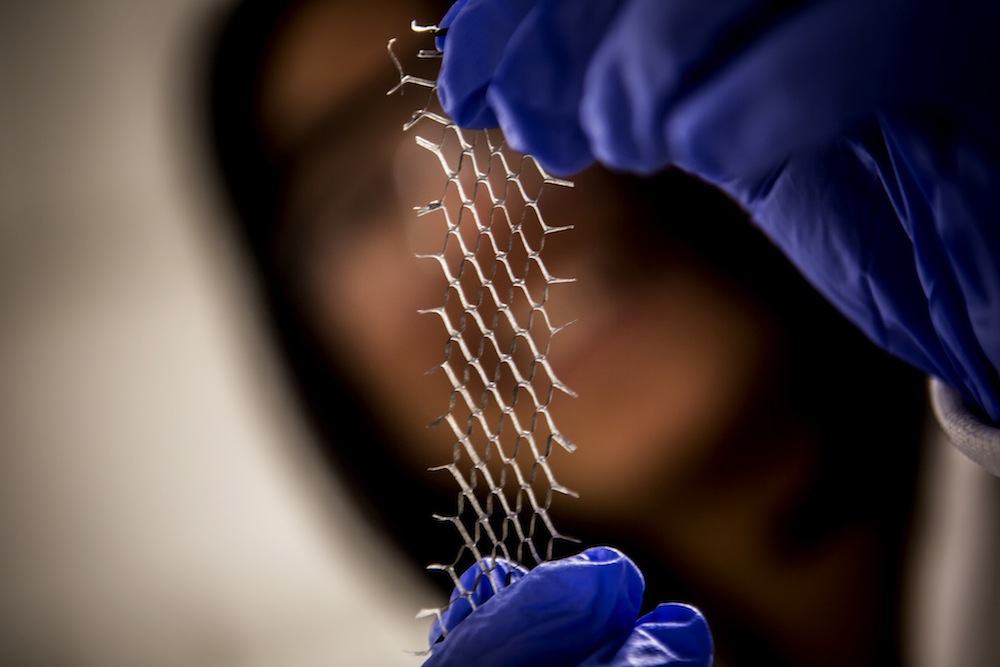Accordion-Like Conductors Could Spawn Flexible Display Screens

Origami-inspired engineering techniques could help researchers develop stretchy conductors for flexible plasma-screen displays and, eventually, solar panels that can bend to follow sunlight, according to a new study.
Increasingly, researchers worldwide are developing flexible electronics, such as batteries and solar panels, that could one day make their way into clothing and even human bodies. But in order to make parts such as wires and electrodes, the scientists need conductors that are just as flexible.
However, stretchy conductors are difficult to design; existing ones either do not stretch much or their conductivity plunges dramatically if they do, the researchers said. [Top 10 Inventions that Changed the World]
Now, for the first time, scientists have used a variation of origami, known as kirigami, to create stretchable conductors. Whereas conventional origami uses only folding to create structures, kirigamiuses both folding and cutting.
Normally, when materials get stretched, they can tear, reducing their electrical conductivity and thus their ability to carry electricity from one place to another. Furthermore, it can be difficult to predict when and where rips will occur, making it challenging to know precisely how the materials' properties might change, the researchers said.
The kirigami cuts reduced the conductivity of the conductors. However, when the conductors were stretched, their conductivity remained steady, said study co-author Sharon Glotzer, a computational scientist at the University of Michigan at Ann Arbor. "The cuts and folds result in the material no longer staying in just two dimensions, but popping out into the third dimension, which is what gives it these extraordinary mechanical properties," Glotzer told Live Science.
The idea for this work came from more than a decade of collaboration between paper artist Matt Shlian and materials scientist Max Shtein, both of the University of Michigan at Ann Arbor and co-authors on the new study. The devices were inspired by a work of art from Shlian in which he cut a sheet of paper so that it extended into a herringbone mesh — a kind of zigzagging pattern used in certain fabrics — when stretched.
Get the world’s most fascinating discoveries delivered straight to your inbox.
"Matt first approached us scientists because he had a hunch his work might be interesting to scientists, and he was looking for inspiration for his art as well," Shtein told Live Science. "What attracted me to his work was how I was then exploring ways to create circuits that could be woven and knitted, and he could intuitively think about how to go from two dimensions to three dimensions."
The first prototype of the kirigami-inspired stretchable conductor involved paper covered in carbon nanotubes — pipes of carbon that are only nanometers, or billionths of a meter, wide that possess remarkable electrical conductivity. The kirigami pattern used was relatively simple, with cuts resembling rows of dashes that opened up to resemble a cheese grater. [8 Chemical Elements You've Never Heard Of]
When this kirigami prototype was placed into a glass tube filled with argon gas and electrical current was run through it, the stretchable conductor turned the argon into glowing plasma, similar to a neon sign. The researchers suggest that arrays of such devices could help make up a stretchable plasma display.
The researchers then developed their concept further by creating microscopic kirigami from sheets of graphene oxide, a material composed of atom-thick layers of carbon and oxygen. They sandwiched these graphene oxide sheets together with a flexible plastic, with up to 30 layers of each. Cuts just a few tenths of a millimeter long were made with the aid of lasers and plasmas.
Ultimately, kirigami patterns could dramatically increase the amount of stretching these conductors are capable of, from 4 percent to 370 percent, the researchers said. "Objects that are ostensibly rigid and prone to failing catastrophically can be made to exhibit a lot of yield," Shtein said.
Moreover, computer models developed by the researchers helped them understand exactly how kirigami patterns may influence the behavior of stretchable conductors. This could help them choose the best kirigami patterns for specific applications. "This opens a whole new realm of possibilities for computer-based engineering of materials," study co-author Nicholas Kotov, a nanochemist at the University of Michigan, told Live Science.
One potential application of these stretchable conductors is solar energy. "We're interested in making a cheap, inexpensive, scalable way to create solar panel materials that can track the sun," Glotzer said.
Origami and kirigami could ultimately serve as a way to store information using folds, Glotzer added. "We're beginning to explore this nearly infinite space of possibilities in design," she said.
The scientists detailed their findings online today (June 22) in the journal Nature Materials.
Follow Live Science @livescience, Facebook & Google+. Originally published on Live Science.



